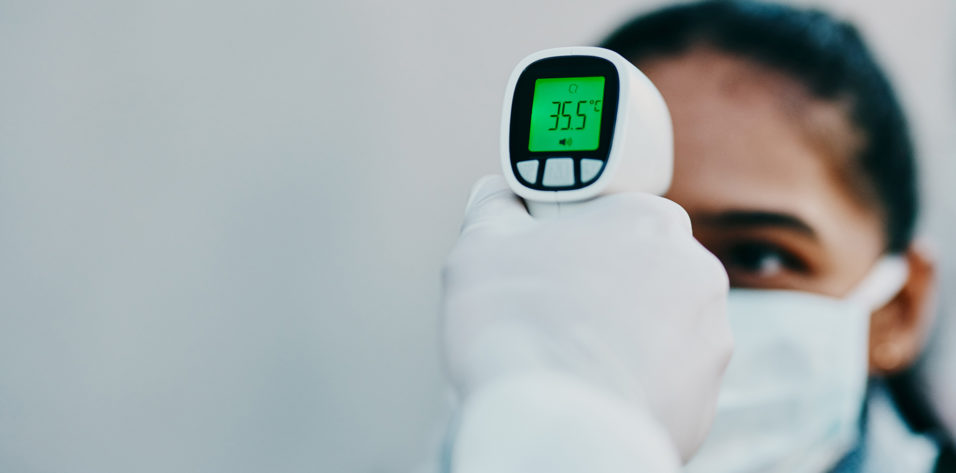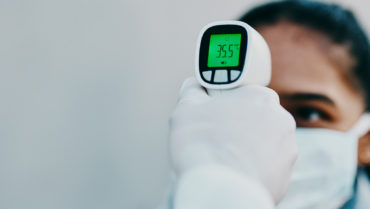
Evaluation of Coronavirus in Tearsand Conjunctival Secretions ofPatients With SARS-CoV-2 Infection
Xia J, Tong J, Liu M, Shen Y, Guo D1
Industry support: No
ABSTRACT SUMMARY
This prospective interventional case series study was conducted from January 26 to February 9 at the First Affiliated Hospital of Zheijiang University in Hangzhou, China. Using disposable swabs, investigators collected tears and conjunctival secretions from 30 patients with confirmed severe acute respiratory syndrome coronavirus 2 (SARS-CoV-2) for reverse-transcription polymerase chain reaction (RT-PCR) assay. The goal was to assess the presence of the novel coronavirus in these secretions to gain insight into its transmission.
STUDY IN BRIEF
A small prospective interventional case series study evaluated the conjunctival secretions and tears of 30 patients infected with severe acute respiratory syndrome coronavirus 2 (SARS-CoV-2) for viral particles. Of the 30 patients studied, the tears and conjunctival secretions of only one yielded a positive reverse-transcription polymerase chain reaction assay. This patient was also the only one with conjunctivitis.
WHY IT MATTERS
The risk of SARS-CoV-2 transmission via conjunctival secretions and tears appears to be correlated with the presence of conjunctival involvement. This finding suggests that eye care providers should maintain a high index of suspicion for SARS-CoV-2 when evaluating patients for nonspecific red eye and take appropriate screening and protective precautions when examining these patients.
Enrolled patients had a positive RT-PCR assay of respiratory or blood specimens and computerized tomography lung imaging findings consistent with viral pneumonia. The investigators subdivided patients into two groups. In group 1, patients met common-type diagnostic criteria (n = 21); in group 2, patients met severe-type diagnostic criteria (n = 9). The severe-type diagnostic criteria were respiratory distress, oxygen saturation 93% or below or arterial partial pressure of oxygen/oxygen concentration FiO2 less than or equal to 300 mm Hg at rest, respiratory failure requiring mechanical ventilation, shock, and other forms of organ failure requiring monitoring and treatment in an intensive care unit.
Two samples were obtained from each patient; the second was taken 2 to 3 days after the first. Conjunctival and tear samples were obtained from the inferior conjunctival fornix.
Two samples obtained from the only patient with conjunctivitis yielded positive RT-PCR results. The 58 other samples were all negative.
DISCUSSION
Identifying patients with COVID-19 has been challenging, especially when they are asymptomatic for the virus or are in its early stages. Early reports suggested that ophthalmologists are at increased risk of acquiring SARS-CoV-2 because a number of them who did not wear ocular protection became infected after being involved in the daily management of patients infected with the virus. This observation raised concern that SARS-CoV-2 can be transmitted through mucous membranes such as the conjunctiva. As a result, health care providers have been advised to wear eye protection.
In this study, the tears and conjunctival secretions of patients with known SARS-CoV-2 contained viral particles only when the patient also had conjunctivitis, which was defined as conjunctival congestion and aqueous secretion. It is noteworthy that this patient had neither fever nor respiratory symptoms at the time of sample collection. Many patients present to eye care providers in an outpatient setting for the evaluation of nonspecific red eye. Based on these findings, eye care providers should take appropriate protective measures for themselves, their staff, and their other patients whenever a patient presents with conjunctivitis. The study findings also suggest that conjunctival secretions and tears are not a common route of SARS-CoV-2 transmission.
Limitations of this study include a small sample size, limited specimen size, and the fact that only one of the enrolled patients had conjunctivitis. Further research is warranted that uses a larger sample size and focuses on patients with confirmed COVID-19 who present with conjunctivitis.
Presymptomatic SARS-CoV-2Infections and Transmission in a Skilled Nursing Facility
Arons MM, Hatfield KM, Reddy SC, et al2
Industry support: No
ABSTRACT SUMMARY
The investigators conducted two serial point-prevalence surveys to assess the transmission of SARS-CoV-2 and evaluate the adequacy of symptom-based screening to identify infections in the residents of a skilled nursing facility. Consenting residents underwent nasopharyngeal and oropharyngeal testing for SARS-CoV-2 that included real-time RT-PCR, viral culture, and sequencing. Any symptoms noted in the preceding 14 days were recorded. Residents who were asymptomatic were assessed for a second time 7 days later. Residents infected with SARS-CoV-2 were categorized as symptomatic with typical symptoms, symptomatic with only atypical symptoms, presymptomatic, and asymptomatic.
STUDY IN BRIEF
The Centers for Disease Control COVID-19 Investigation Team evaluated the transmission of severe acute respiratory syndrome coronavirus 2 (SARS-CoV-2) and the adequacy of symptom-based screening to identify infections in the residents of a skilled nursing facility. Residents who were asymptomatic were assessed for a second time 7 days later. More than half of the residents who tested positive were asymptomatic at the time of their first test.
WHY IT MATTERS
This study highlights the significant role of asymptomatic individuals infected with SARS-CoV-2 in transmission of the virus. The findings indicate that infection-control strategies focusing on only symptomatic residents are inadequate for identifying and preventing the spread of this virus. As medical practices resume operations, it is critical that they implement SARS-CoV-2 screening protocols that account for asymptomatic carriers and presymptomatic patients to keep patients and health care staff members safe.
Twenty-three days after the first positive test result in one of the facility’s residents, 57 of 89 of the residents (64%) tested positive for SARS-CoV-2. Of the 76 residents who participated in the point-prevalence surveys, 48 (63%) tested positive. Of these 48 residents, 27 (56%) were asymptomatic at the time of testing, and 24 subsequently developed symptoms. Viable virus was recovered from 17 of these 24 presymptomatic residents. Mortality in this facility was 26%.
This study demonstrates rapid and widespread transmission of SARS-CoV-2. More than half of the residents who tested positive were asymptomatic at the time of testing, showing that focusing infection-control strategies on only symptomatic residents was insufficient to prevent the transmission of SARS-CoV-2.
DISCUSSION
This study illustrates several critical points about screening for SARS-CoV-2 infection and preventing virus transmission. First, strong screening protocols for health care workers are essential to preventing SARS-CoV-2 transmission, and the use of appropriate personal protective equipment is crucial for the safety of patients and health care workers alike. This nursing facility implemented enhanced infection-control methods on February 29. Residents were assessed twice daily for signs and symptoms. Health care personnel were screened for symptoms, and their oral temperature was checked at the beginning of their shifts. Nevertheless, a member of the health care staff tested positive for SARS-CoV-2 on March 1 after having worked in one of the facility units on February 26 and 28 while symptomatic, and a hospitalized resident of that unit developed symptoms on March 2 and was diagnosed with COVID-19 on March 5.
Second, given the high percentage of asymptomatic residents, transmission from these individuals likely contributed significantly to the rapid and wide spread of the virus. The doubling time of the virus in the facility was 3.4 days compared to 5.5 days in the surrounding county. Laboratory testing confirmed quantifiable and significant levels of viral RNA in symptomatic residents, which means that viral shedding could and likely was occurring and fueling transmission. Symptom-based strategies appear to be insufficient for preventing the spread of the virus in a skilled nursing facility and likely in other health care facilities.
This study has limitations. First, errors in symptom classification of the residents could have occurred because of difficulty with history taking or confounding by concurrent health conditions. Second, there is a higher prevalence of comorbidities and an age bias in a nursing home population compared to the general population. This study’s findings therefore may not be applicable to the general population. Third, the investigators did not test asymptomatic health care workers in the facility.
1. Xia J, Tong J, Liu M, Shen Y, Guo D. Evaluation of coronavirus in tears and conjunctival secretions of patients with SARS-CoV-2 infection. Published online February 26, 2020. J Med Virol. 2020;92(6):589-594.
2. Arons MM, Hatfield KM, Reddy SC, et al. Presymptomatic SARS-CoV-2 infections and transmission in a skilled nursing facility. N Engl J Med. 2020;382(22):2081-2090.




